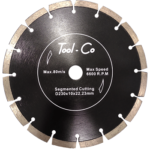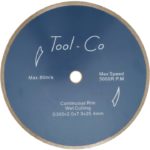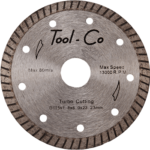The Three Main Rim Styles of Diamond Saw Blade
There are many different styles of diamond saw blade rim, but there are three main types available. Each has its own specialised use with its own pros and cons; Segmented Rim, Continuous Rim, and Turbo Rim.
Segmented Rim
The Segmented Rim gives the roughest cut and is generally used in construction for concrete, brick, stone, masonry/block, and hard/reinforced concrete. This blade is usually referred to as a dry cutting blade. It can cut without water because of the blade’s cut outs—or segments—on the edge, which allows air to flow and cool down the blade core. The blade’s segments also allow for better exhaust of debris, allowing for a swifter cut. One of the risks to the lifetime of a diamond blade is overheating, which affects the bond and can lead to the blade warping. These blades are generally your best option for when water is not readily available.
Continuous Rim
The Continuous Rim blade is most commonly a wet cut blade but could also be a dry cut blade. There are a few advantages to using water when cutting material: Water significantly cools down the blade, allowing for longer life; it flushes out any debris to lessen friction in the cutting zone; and it reduces dust, thus preventing build-up in the cracks, which would decrease the tool’s lifetime. The continuous rim cuts the slowest of any of the different styles of diamond saw blades, but as a trade-off, it produces the cleanest cut, which is one reason it is favoured in tile cutting.
Turbo Rim
The Turbo Rim Diamond Blade is designed to cut faster in wet or dry applications. The smaller segments on the rim allow for cooling of the blade with an interweaving diamond matrix. The turbo rim lets air pass through its smaller turbo segments, which has a cooling effect on the blade. Generally, there are small holes scattered throughout the blade as well. This is a feature that is used to increase the cooling capabilities of our diamond blades.



